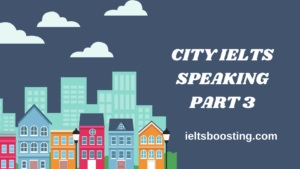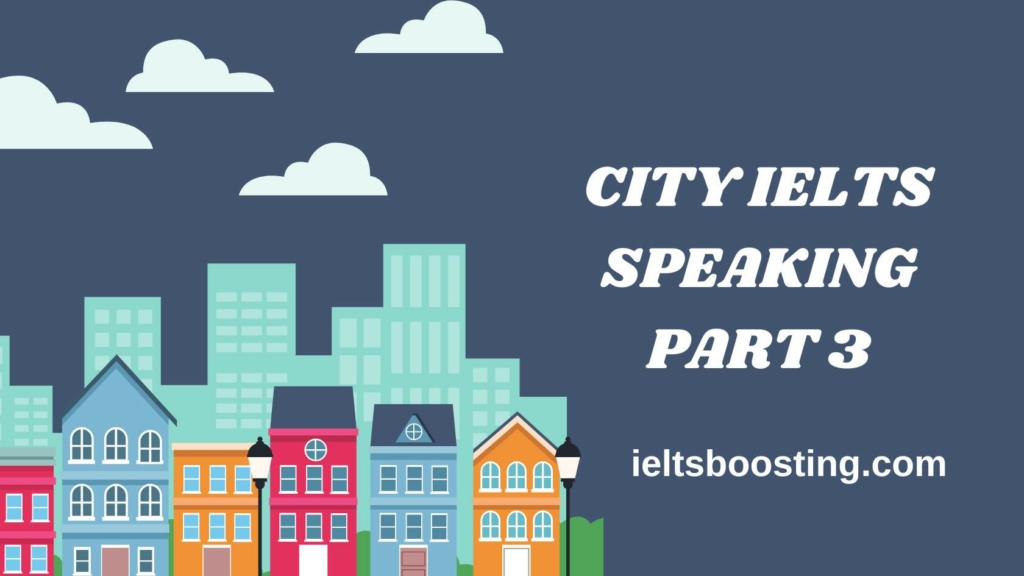City ielts speaking part 3
IELTS Speaking Part 3 questions related to the topic of cities
What are some advantages of living in a city?
Living in a city has many advantages. For one, cities often have better infrastructure compared to rural areas. This includes better schools, hospitals, and public transportation systems. Additionally, cities offer a wide range of job opportunities across various industries. There’s also the benefit of having easy access to a variety of services and amenities, such as shops, restaurants, and entertainment venues. Lastly, cities are often cultural melting pots, offering diverse cultural experiences, from food to art and music.
What are some problems that cities face today?
Cities today face a number of challenges. One of the most pressing issues is traffic congestion, which can lead to long commute times and contribute to air pollution. Speaking of pollution, waste management is another major problem in many cities. Then there’s the issue of housing. With the high cost of living, affordable housing is becoming increasingly scarce in many cities. Other issues include social problems like crime and homelessness, and the strain on public services and infrastructure due to growing populations.
How can governments make urban life better for everyone?
Governments can improve urban life by investing in infrastructure, such as public transportation, roads, and utilities. This can help reduce traffic congestion and improve the quality of life for residents. They can also implement policies to support affordable housing and combat homelessness. Additionally, governments can promote economic development and job creation in cities, which can help improve the standard of living. Lastly, it’s important for governments to invest in social services, education, and public safety to ensure a high quality of life for all city residents.
Do you think life in a city is better than life in the countryside?
Whether city life is better than life in the countryside really depends on personal preference. Some people thrive in the hustle and bustle of the city, enjoying the fast pace of life, the convenience, and the wide range of opportunities and activities available. On the other hand, some people prefer the peace and quiet of the countryside, the close-knit community, and the connection to nature. Personally, I enjoy the convenience and diversity of city life, but I also appreciate the slower pace of life and the tranquility that the countryside offers.
IELTS speaking part 3 why questions-how to produce band 7 answer
How have cities in your country changed over the past few decades?
Cities in my country have changed a lot over the past few decades. There’s been a lot of development and modernization, with new buildings, shopping centers, and infrastructure being built. This has led to improved living standards and more job opportunities. However, this rapid development has also led to some problems, such as traffic congestion, environmental pollution, and rising living costs. Despite these challenges, I believe that the changes have been largely positive and have contributed to the economic growth and progress of my country.
What do you think cities will be like in the future?
I think cities of the future will be more sustainable and tech-driven. We’ll see more green buildings, renewable energy sources, and smart technologies that make city living more efficient and convenient. I also think there will be more emphasis on creating green spaces and promoting active lifestyles to improve the health and well-being of city residents. However, it’s also crucial that future cities are inclusive and affordable for everyone, regardless of their income level.

City ielts speaking part 3
How does living in a city affect people’s lifestyles?
Living in a city can greatly affect people’s lifestyles. City dwellers often lead a fast-paced life due to the dynamic nature of urban environments. They have access to diverse cultural, entertainment, and dining options, which can enrich their life experiences. However, city living can also mean dealing with traffic, noise, and sometimes, a higher cost of living. It can also impact health and wellbeing, with city dwellers often facing issues like pollution and lack of green spaces.
What role should local government play in urban planning?
Local government plays a crucial role in urban planning. They are responsible for zoning, which determines how land in a city is used, whether it’s for residential, commercial, or industrial purposes. They also oversee the development of infrastructure like roads, parks, and public buildings. Moreover, local governments have a duty to ensure that urban development is sustainable and inclusive, providing affordable housing options and ensuring that all residents have access to essential services.
How can cities be designed to be more sustainable and environment friendly?
Cities can be designed to be more sustainable and environmentally friendly in several ways. This includes promoting green building practices, improving waste management, and investing in renewable energy sources. Urban design should also prioritize green spaces, which not only improve air quality but also provide residents with areas for recreation. Additionally, cities can be designed to be more walkable and bike-friendly, reducing the reliance on cars and thus lowering carbon emissions.
How important is the role of public transportation in city life?
Public transportation plays a vital role in city life. It provides an affordable and efficient means for people to get around, especially for those who don’t own a car. A well-functioning public transportation system can help reduce traffic congestion and lower carbon emissions, contributing to environmental sustainability. It also promotes social inclusivity by ensuring that everyone, including those with low incomes or disabilities, has access to transportation


